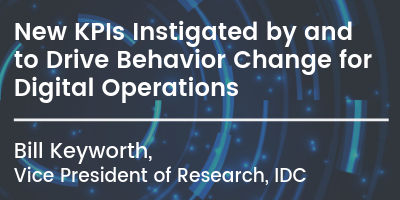 Authored by: Bill Keyworth, Vice President of Research, IDC
Authored by: Bill Keyworth, Vice President of Research, IDC
Track Speaker, April 10, 2018, CIO Peer Forum
Digital technologies and the new business models they fuel have significantly impacted most enterprises. Executives are called upon to leverage digital transformation (DX) to change and disrupt their business, customers, markets, and competitors. This shift is driving tremendous changes to the rules for IT measurement as many IT organizations still lack the culture necessary to run IT as a service business and to address the business value of their contribution to enterprise imperatives.
Traditional IT measurement, with its long-term focus on efficiency metrics for managing infrastructure, applications, and components, is no longer adequate. A new IT contract with line-of-business (LOB) executives continues to mandate reliability, availability, responsiveness, and flexibility for delivery of IT services critical to achieving target business outcomes … but “more” is now the imperative for IT metrics that matter. IDC identifies three compelling drivers of IT’s urgent need for “more” regarding metrics:
- Impact of Digital Transformation
- Multiple tiers of IT services
- Running IT as a service business
Impact of Digital Transformation
In recent years, enterprise leaders have sought to disrupt their markets and competitors through DX enabled by cloud, mobile and data technologies and accelerated by new digital technologies such as Internet of Things, robotics, 3D printing, cognitive interfaces and virtual reality. DX is effectively driving changes to business models, customer relationships, and partner expectations, and it has fundamentally and permanently altered the culture, metrics, processes, and tools critical for effective IT measurement. The acceptability of traditional IT operational metrics and key performance indicators (KPIs) that document IT’s efficiency is history.
DX requires differentiated measurement of IT’s immediate contribution to business objectives. Like the delivery of water and electric utilities, LOBs simply expect reliable, high-performance IT services without having to understand the distribution channel, storage mechanisms, and utility’s source. LOBs now demand IT capabilities when and where they’re needed to achieve DX goals. Delivery of IT technical services is of minimal interest to LOB executives whose career, salary, and bottom line are focused on achievement of digitally oriented business outcomes.
Multiple Tiers of IT Services
Traditional make-sell business models are being supplanted by platform-oriented, multisided, on-demand, and other approaches that require businesses to culturally interact and work cooperatively with external agents. IT executives are stepping up to the necessity of high-quality “foundational” traditional IT services as well as critical IT “business” services demanded by enterprise users. However, in addition, external customer-facing and business ecosystem-facing services are rapidly evolving to innovate, create, and manage the new types of revenue-generating products, services, and customer experiences by the business.
The plethora of digitally enabled products using IT services created or procured on the fly too often results in a degraded customer experience and internal finger-pointing. Failure to adapt to the demands of a multi-tiered service delivery eventually leads to a brittle, poorly connected set of products that can’t scale and don’t engage customers. IT organizations that have a well-thought-out, layered set of services, which start from basic IT and infrastructure services and extend to enterprise applications and business services, customer-facing business services and, finally, business services that reach ecosystem partners and stakeholders, are strengthening IT’s deliveries of service initiatives. Each layer is critical as it supports the layers that rest upon it and greatly enhances the measurement and delivery of all types of IT services for effective achievement of target business outcomes.
Running IT as a Service Business
Digital competencies are demanding a new level of professional business acumen within IT for “running IT as a true service business.” This new IT operational strategy is transitioning IT from an engineering-driven culture to a service-delivery culture with a new DX operating/financial model. Statistically, these kinds of CIOs and IT executives are better at creating and measuring a viable and competitive IT services business specifically for digital transformation. Considerations prompted by this trend include:
IT organizations that are culturally successful at adopting “IT as a service business” are improving the integration of their DX innovations with legacy systems and are providing consistent standards of service assurance (i.e., operational stability, timeliness, and security) for new IT services that business leaders and customers expect from existing platforms. By enabling more expansive visibility into application performance, dependencies, and overall efficiencies, those executives who run IT as a service business come closer to enabling a competitive price for the IT services provided, one that is based on some measure of IT services consumed.
